
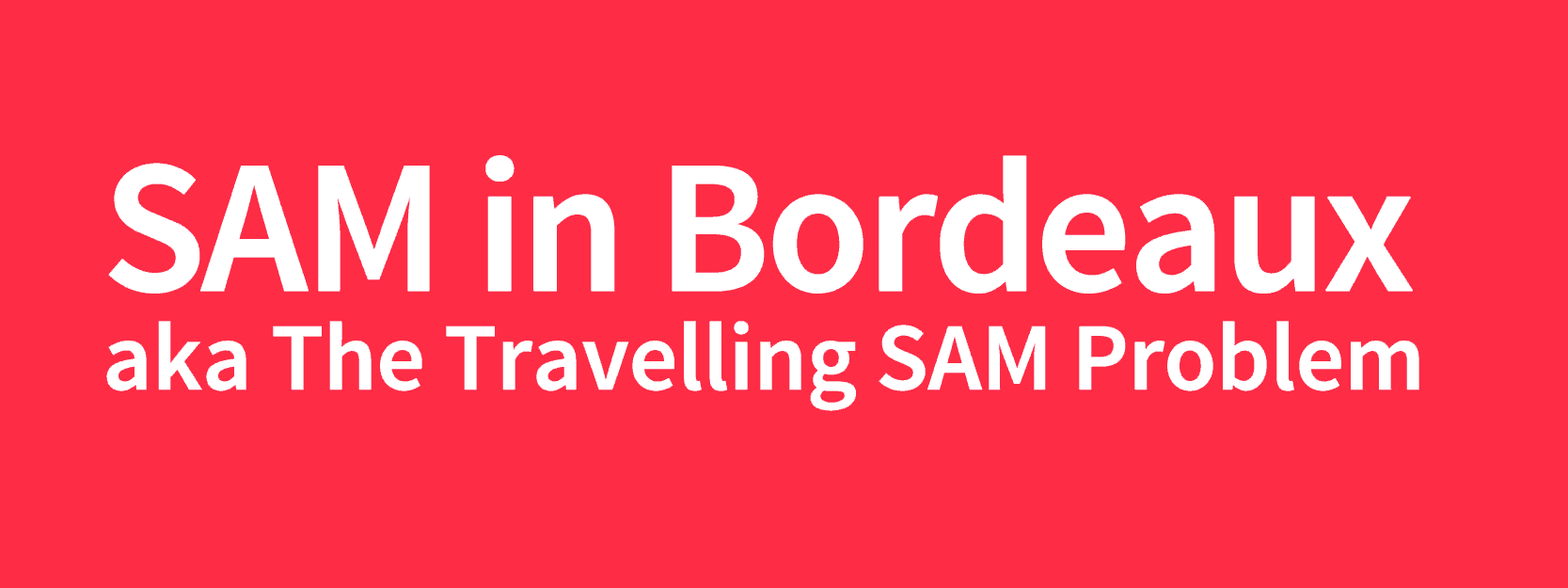

SAM was kindly invited to a special event in Bordeaux to start 2017 in full swing. As guest artist with the principal role of furnising the window of France's main independent bookstore, la librairie Mollat, the stakes were high. Would SAM live up to the expectations ? Furthermore, would SAM manage the challenge of performing that most tedious yet intriguing of tasks - TSP or the travelling salesman problem?
Before delving into that most trivial task of describing the infamous TSP algorithm for which the majority of SAM's drawing productions have relied upon up until now, there was a slightly more pressing worry for Team SPAM with this event. Would SAM endure the journey? It has to be said, this was the first event in which we needed to dismantle the various parts, wrap them up with care and walk them through the manic and precarious French transport system. It was my principal worry in any case. It's a sensitive machine and once arrived in Bordeaux, would I manage to get it up and running again? Suspense …
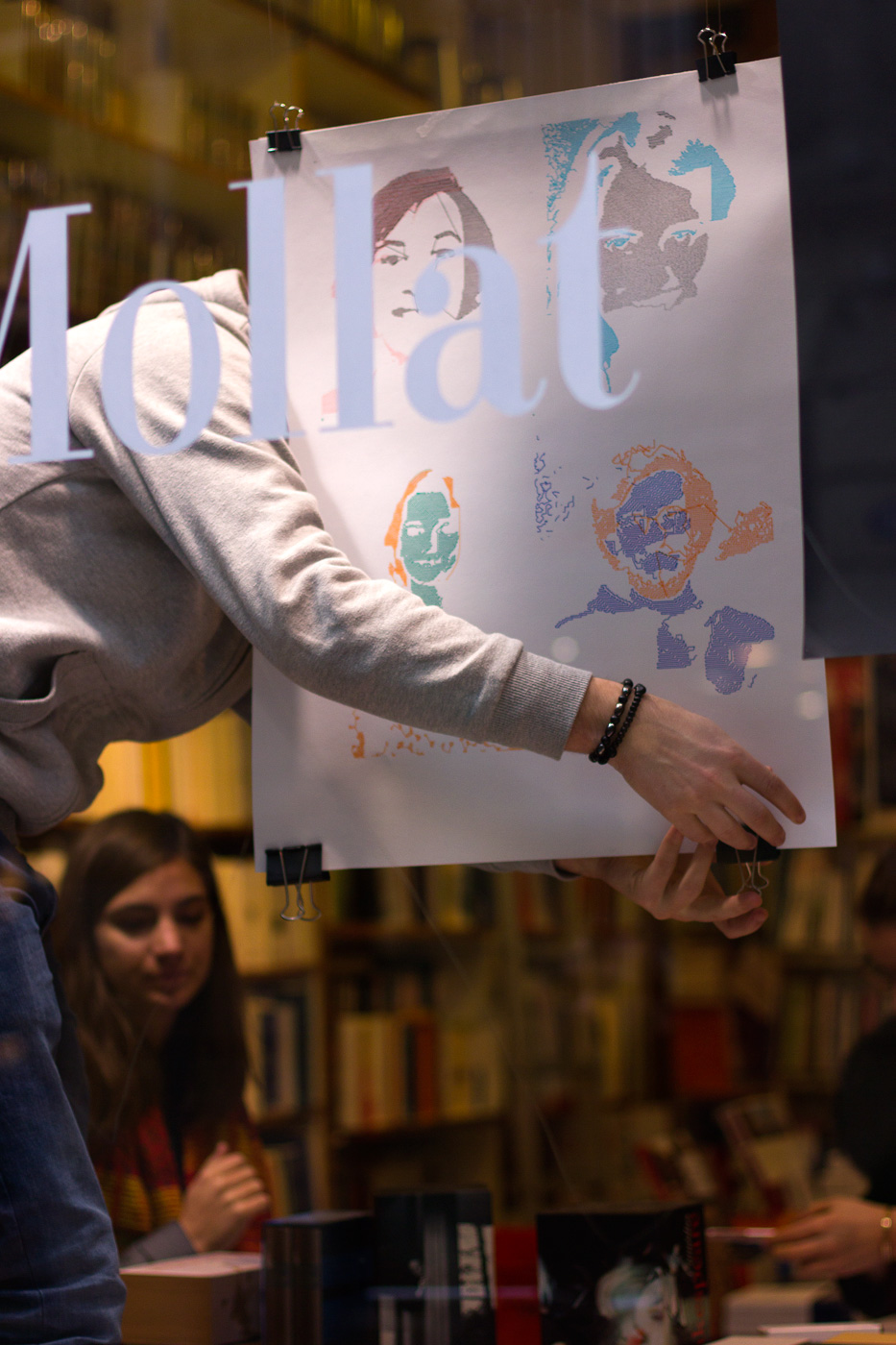
SAM inda house chez Mollat - Team SPAM - 2017
Some stuff
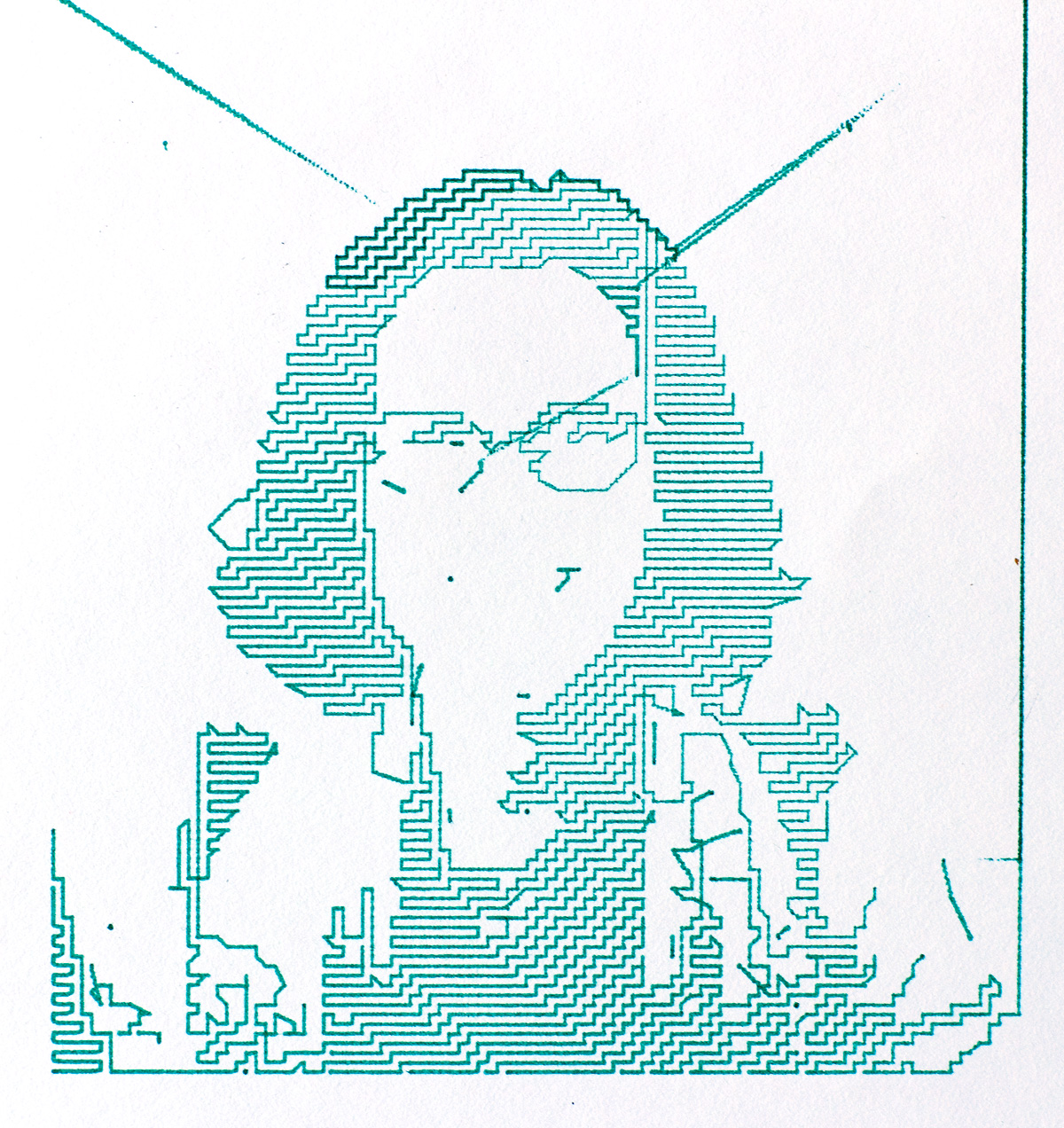
Test image for TSP Algo
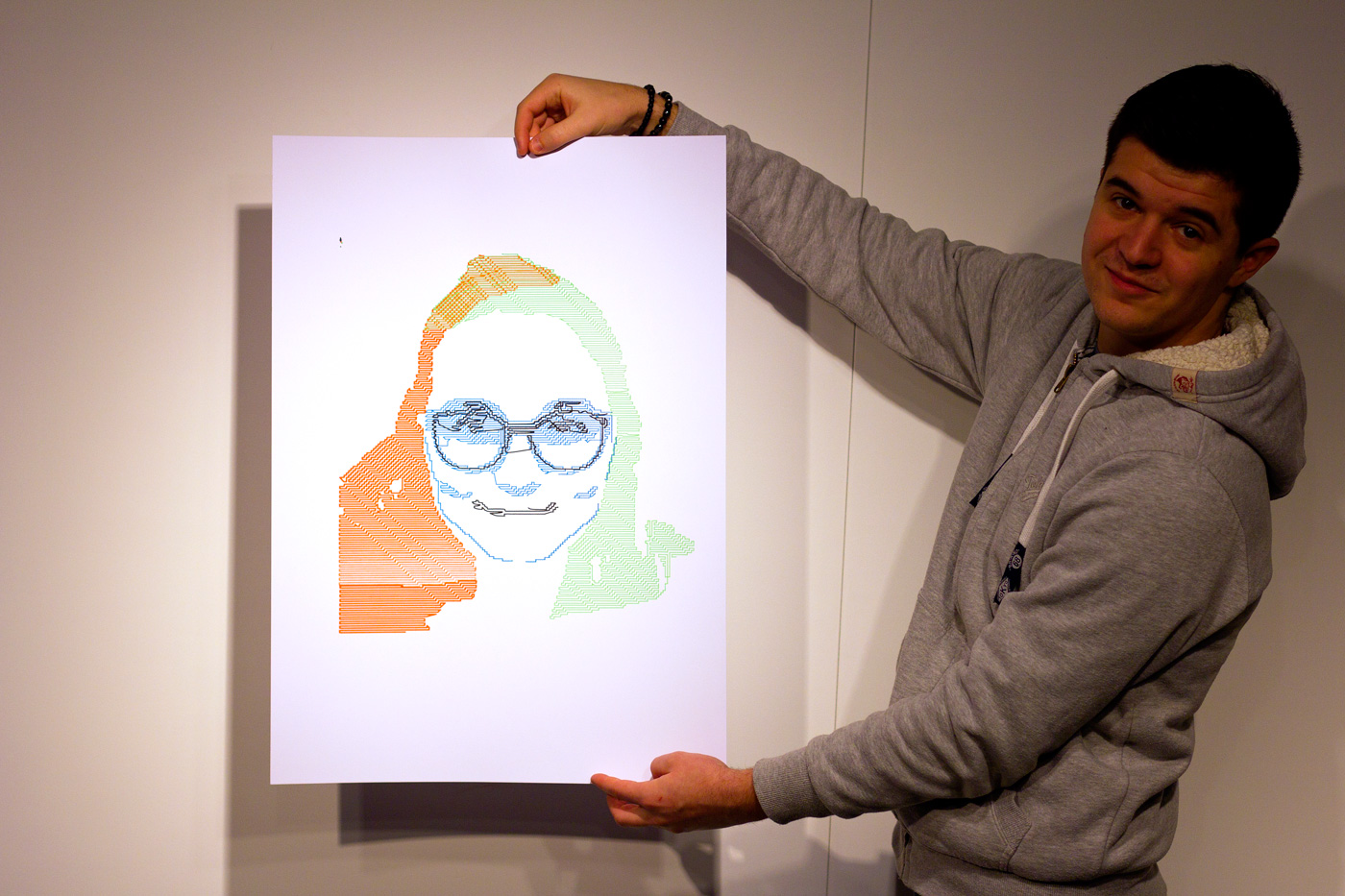
Student work

Window TSP art shopping
What was this event then? It's a good ol' story of how creative minds bring their work together. Back in summer, I'd made a little trip to see my good friend, Julien Gachadoat, captatin coder extraordinaire and right hand man to a number of past collaborations. We were talking one evening about the various challenges in teaching code to artists and designers, especially within the environment of an art school. Our discussion focused on pedagogy and the challenges in opening up students' minds to this relatively new medium. It's a passionate and on-going discussion for which we both engage with and have continued to do so for many years. As we bantered on, I realised that Julien was concocting a vague idea in his head. Put to questioning, he revealed an intention of getting his graphic design students to work on an installation piece. An ambitious means for production but more importantly, a means for teaching the fundamentals of manipulating pixels in the medium of code.
Currently Reading & Listening
A Beautiful Question. Frank Wilczek.
Algorithmes. La Revue Science du Design #04.
Oeil ouvert et coeur battant. François Cheng
Nigerian Soul Fever. Soul Jazz Records

Traditional Teaching Methods
Two drinks on, SAM was in the subject of conversation and we left it at that. A few weeks later, and SAM had become the main character in a story that was taking on another dimension. A mix of face detection, window gazing, book perusing, TSP art and a clandestine production space hidden away in an old Fina garage just seemed too good to be true. So, the project got the thumbs up from both the school and one of France's main independent bookstores, la librairie Mollat. We had a week to work with ten students from ECV Bordeaux introducing them to the finicky workings of SAM and with the sole aim of producing a maximum of drawings to furnish one of their finest of display windows. The challenge was on.
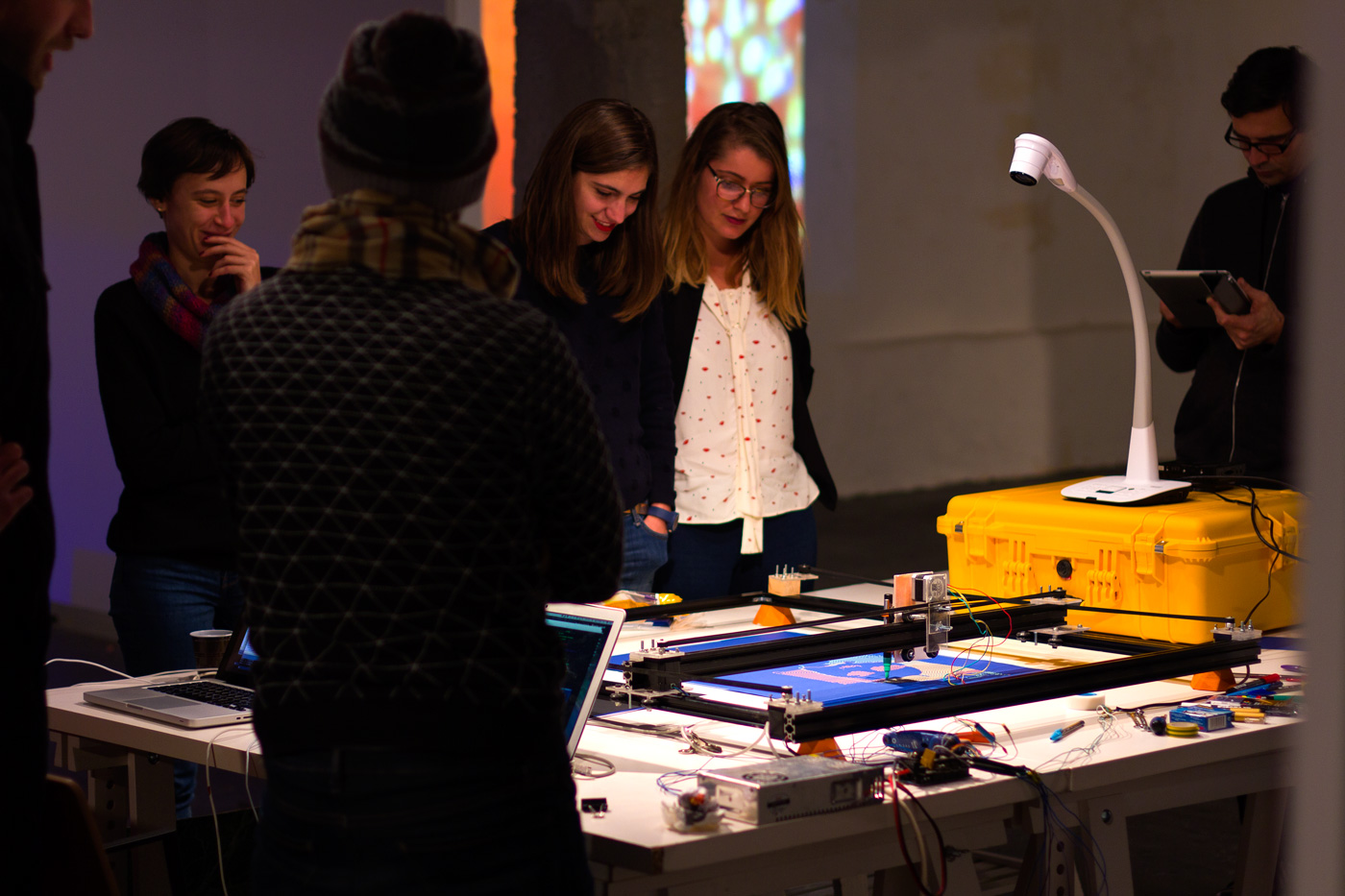
SAM meets the students - Team SPAM - 2017
TSP Part I
Up until now, out little drawing machine has produced art based on a simple algorithm named TSP or the travelling salesman problem. One could easily lose a week on researching this problem, for which there is ample reading material on the web. It's described in many flavours, has multiple applications and a number of optimal solutions. The problem is the following ; from a given array of points in a 2D plane, what is the shortest path to travel from one point to the other without visiting twice any given point ? Eh, what's the relation there you may well ask ? Well, on a practical level, our goal with SAM is to calculate a path for drawing and one that joins neighbouring points. We had been using a simple pixel brightness threshold from a given bitmap image to calculate and store an array of points. In our thinking, we want to sort this list of points and send these as coordinates to the machine to draw, hence the TSP algorithm. The aesthetic that emerges from this drawing strategy is quite striking and particular. As one student remarked, "it looks like an electronic circuit board." Indeed, the TSP algo is used in automating the manufacture of micro-circuits so the link is logical.
Some Handy Links
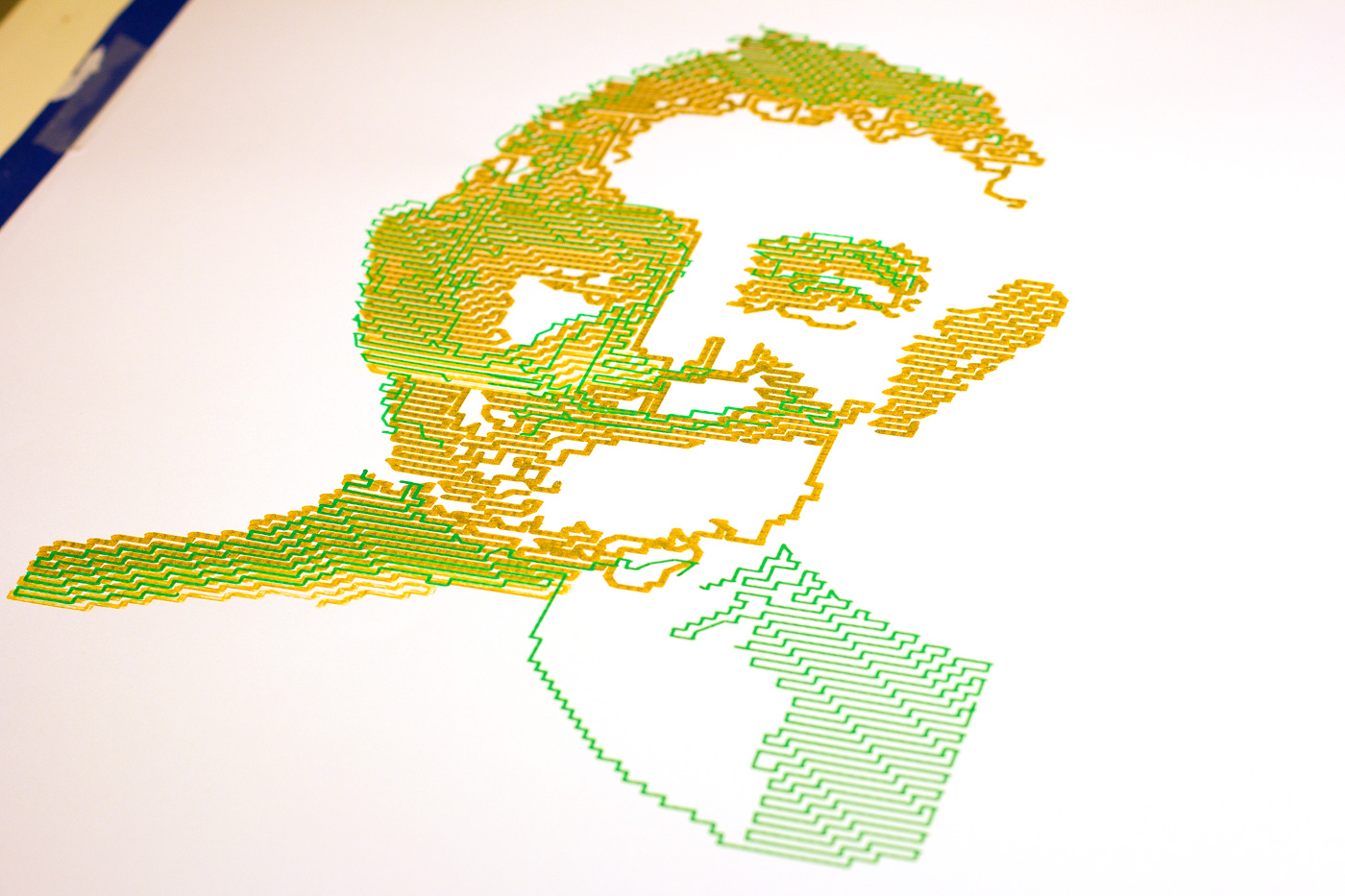
Who is that?
Furthermore, that link is interesting. It reinforces on a purely visual level this idea of the machine executing a pre-set list of instructions, an algorithm as such. In all the fuss today with AI and machine learning, we tend to forget this basic premise that the machine is not a consious entity and is incapable of 'knowing' anything about art, drawing or aethetics. It follows machine commands, precisely and extremly quickly. It just so happens that humans define and write those commands. Any belief in a machine on a par with the human is but an illusion and the day the collective self has been duped into such thinking, will unfortunately be the day mankind has reduced the human to a machine - a rather stupid piece of machinery. What many see as a human activity - that of drawing - is but a list of coordinate points. Those thoughts also brings us back to the ultimate question on our minds since the beginning of this little project; what does SAM draw?

Screen Shot/p>
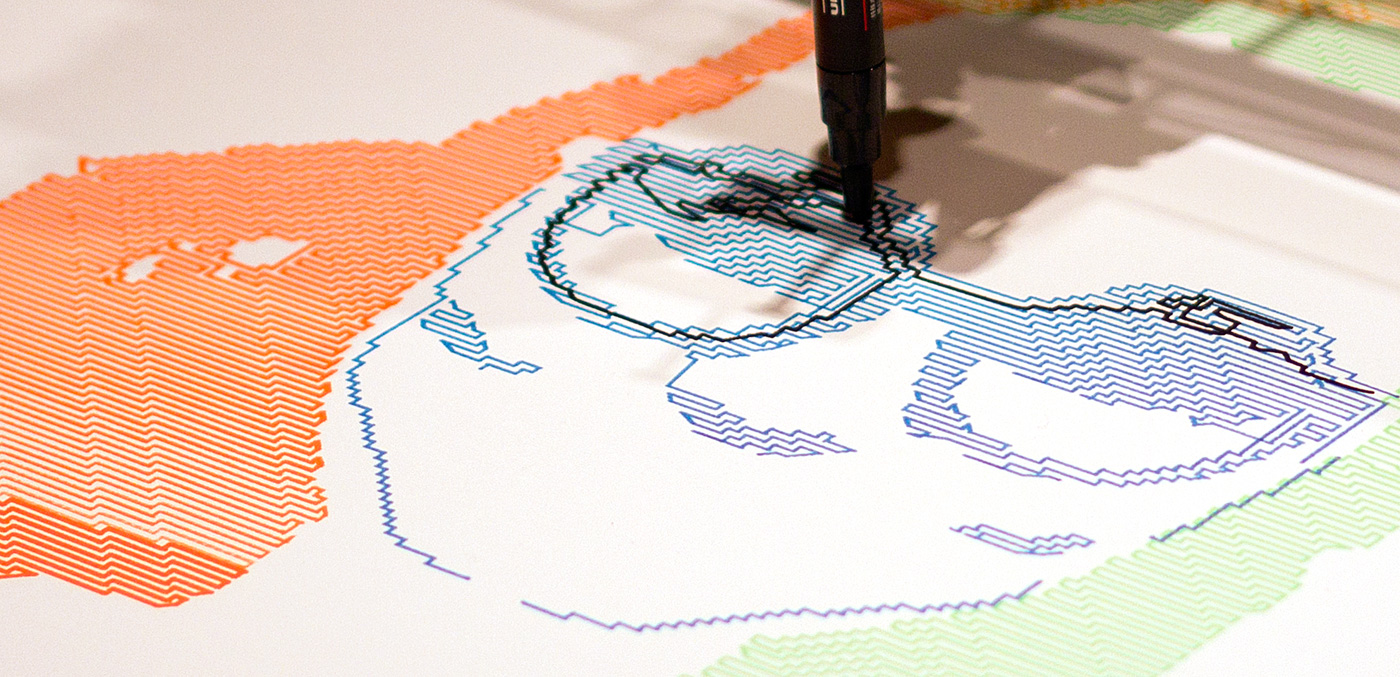
Lea à la cool - Team SPAM - 2017
AI. A Different Read
Interview with Joseph Wiezenbaum
The Man Would Teach Machines to Think.
Computer Power & Human Reason.
Frolicsome Engines. The Long Prehistory of AI.
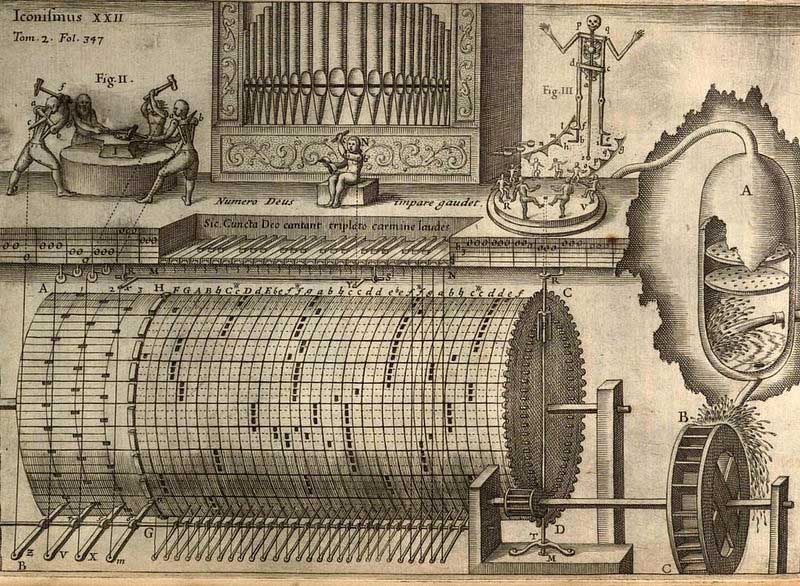
Kircher's Hydraulic Organ. 1650
The TSP algorithm is a nice starting point from which to begin exploring that question because it's such an infamous algorithm that has its roots firmly linked with algorithmic thinking and a fundamental engineering problem - what's the optimal path to follow for a given set of locations or points. Using that as a strategy for generating a path for SAM to draw is an interesting little challenge. We are already experimenting with a few other algorithms and notably one that may well use Julien Gachadoat's library, Blob Detection for Processing. So, keep posted, the project continues.

TSP Algo aesthetics à la Gold - Team SPAM - 2017
Further Personal Documentation
TSP Part II
Getting SAM into a suitcase and travelling across France without being arrested for suspicious packaging and a dirty beard. This was the second major challenge in the project. Would SAM make it to Bordeaux in one piece (after re-assembly of the various parts) and still draw TSP art? Well, to kill the suspense abruptly, of course albeit with a few twists on the way - otherwise you'd just not want to read on if there weren't some crusty facts and caper.
Although the main structure for the machine is made of aluminium, there are various parts that remain far from robust and far from possible damage. Namely, SAM's brain and nervous system needs to be housed with some hardy structure and we'll need to work on that for the future. For the project CODEX, it took a good morning to put the machine together and do a few drawings for testing and calibration. Problems did arise during the course of the week. A broken wire set off panic stations at one moment, putting SAM into a coma state for a good hour before I'd found the problem and operated in situ. It raises another question, how do we go about testing our electronics and eventually finding the problem ? No idea for the moment, so if anyone is reading this and has the answer, please send us a message. We'd be most happy to hear from the outside world :-°
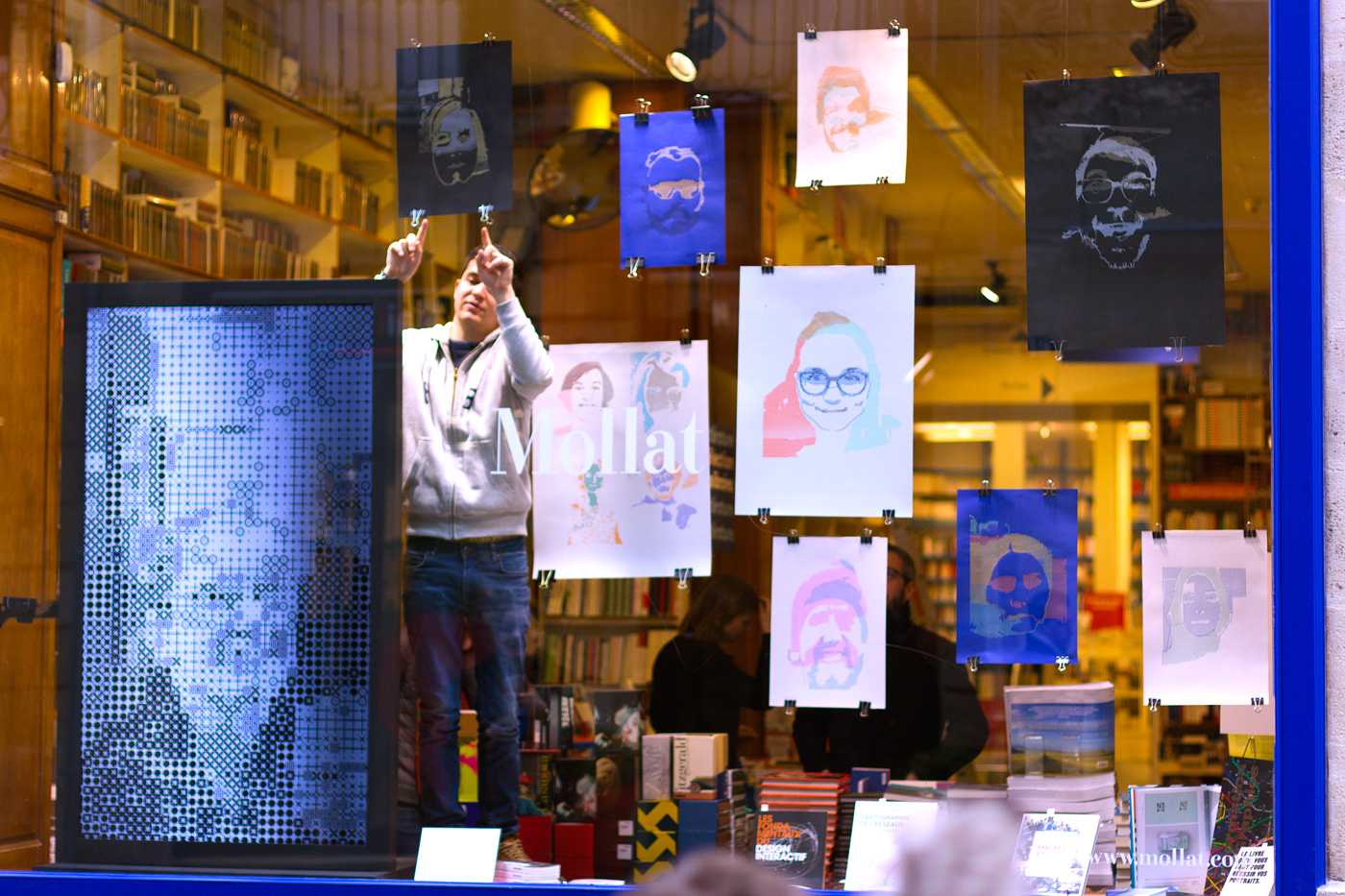
Mollat's pretty window display - Team SPAM - 2017
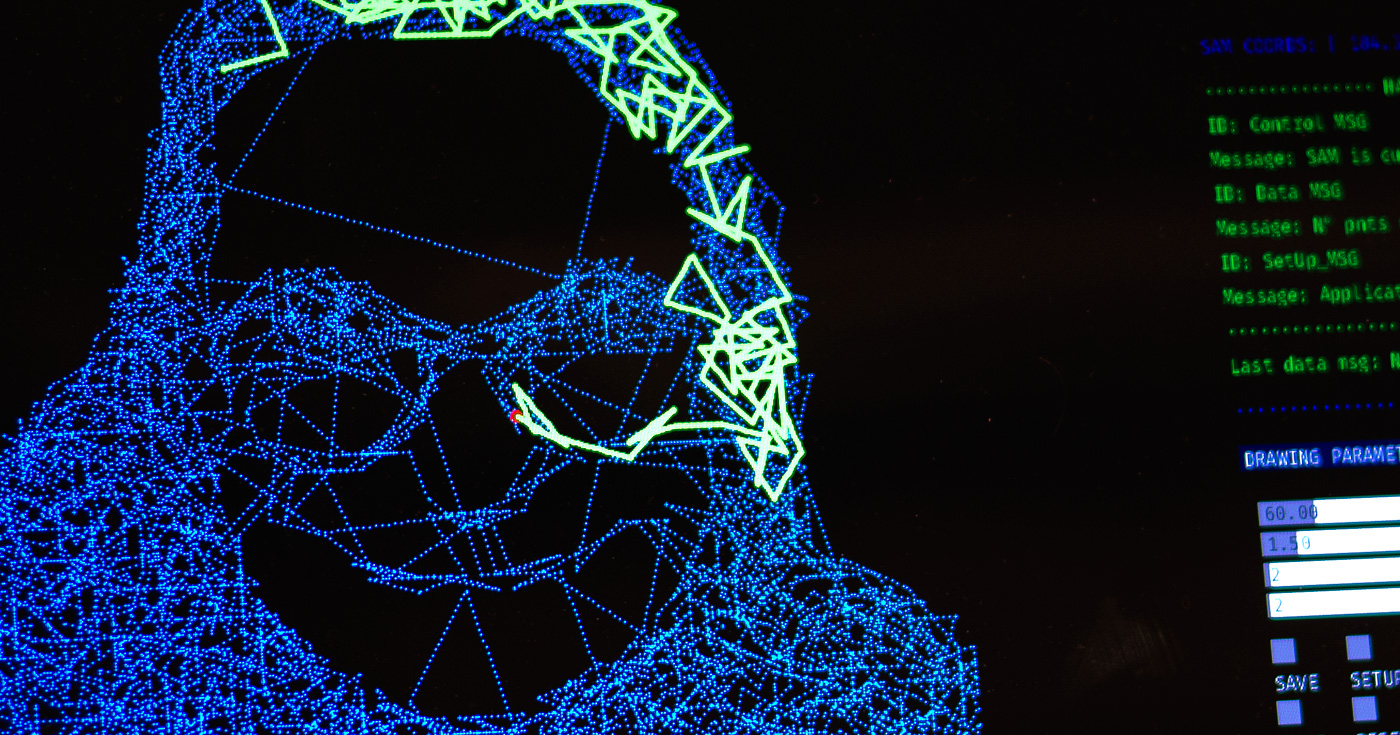
Drawing strategy #02 - Team SPAM - 2017
What have we learned ?
SAM can travel and has mastered the Travelling Salesman Problem. Students got to play and experiment with the machine as well as produce a nice window display featuring TSP artwork drawn by SAM :—) Being fondled by a bunch of budding artists is risky business. Lucky that SAM was up for the challenge and the show.